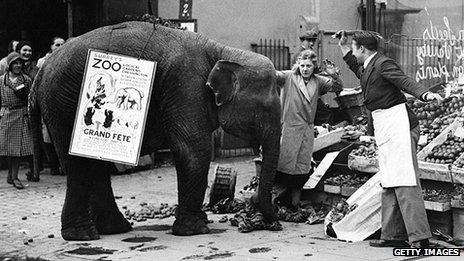Going digital: The future of advertising
- Published

Ad attack: Today's advertisers don't have to worry about campaigns running amok like this elephant in 1932 - but they do need to chase digital engagement
As part of the Technology of Business series, each week we ask an expert in their field for their thoughts.
<italic>Andy Hart is the general manager of Microsoft's Advertising and Online division in the UK. He is responsible for growing Microsoft's online properties, including MSN.co.uk, Bing, Windows Live, Xbox and Windows Phone.</italic>
Technology is becoming ubiquitous: it's almost everywhere, often invisible (or at least transparent), usually locatable, probably connected to the internet, and becoming more natural to use every day.
A new car, for instance, contains an array of technologies: it's a powerful computer, it may be voice-enabled, and it can be a web browser and a phone, among other things.
This means that the number of ways in which people can interact with or experience brands is rapidly increasing.
This presents a huge opportunity, and a huge challenge, for advertisers.
Digital technology and the internet - and the explosion of mobile and other web-enabled devices over the past few years - is turning advertising on its head.
Old school
In the old days of advertising (e.g. a few decades ago), things were simple.
TV, print and radio were the key media for advertisers to convey their Big Idea to large groups of people in a controlled manner.
Now we have digital too, which isn't just another channel. Digital connects old and new media formats whilst simultaneously being a catalyst for thousands of other medias.

Andy Hart: Advertisers can't rely on users to just watch them anymore
People are looking at many different screens for advertising.
Our research, <link> <caption>What's On Their Screens, What's On Their Minds (2011)</caption> <url href="http://www.pmalink.org/resource/resmgr/PDF/multiscreenconsumermicrosoft.pdf" platform="highweb"/> </link> , showed that the group of adults who own and use a TV, and who access the internet via a computer and smartphone on a weekly basis - the 'multi-screen consumer' - doubled between 2010 and 2011, to an estimated 6.5m in the UK alone.
Even a TV these days, like a new car, is also a web browser, and as such can be used to make video calls, network and play games, amongst myriad other activities.
Advertisers can't rely on users to just watch them anymore. Nor can they be so sure that viewers will watch a prime time show at prime time, or in their homes, or out of work hours.
Two-way conversation
Thanks to this new technology, and the ways in which people use it, the manner in which they experience brands has been fragmented and disrupted, and, with the arrival of social media in particular, the former one-way communication between advertisers and consumers has become a dialogue.
That is to say, the future of advertising isn't just about technology: people are also driving it (as they always have, of course, but in a far more profound and dynamic way than before).
As consumers, we are moving objects, we can skip or turn off ads, we can opt out, and we can choose not to engage with a brand.
Conversely, we can become brand advocates and may interact with ads across a number of platforms and formats, off and online.
In addition to getting the creative story right, advertisers need to position brands so they are relevant or useful to increasingly demanding consumers.
Another key finding of the study above was that multi-screen consumers want relevant, consistent and connected advertising and content experiences across their screens.
To do this, planners and strategists need to know what people are doing, on what devices, where, when and why.
A global study we conducted, Context Matters (2010), found that the morning is the key time for use of the internet for social activities, while the evening is more for entertainment.
Internet users are most open to ads when surfing, purchasing and information seeking.
Such consumer insights and demands have been a key driver of the development of our concept, 'polymorphic advertising', which involves ads or related creative assets, such as videos, copy, images or logos, being assembled in such a way to fit various devices or ad formats.
This allows a consistent story to be conveyed across multiple screens, and tailors each asset according to the specific interactive characteristics of the device they appear on.
Personal services
As technology becomes more ubiquitous, and things like tables, walls, fridges and other surfaces, objects and devices become interactive, connected and locatable - and possibly even aware of other devices and people around them - advertising will become even more personalised, contextual, relevant and useful.
It will have to do this to succeed.
This is looking a few years into the future, but the foundations are here now.
For example, we're continuing our research and innovation in the areas of multi-touch, gesture recognition and natural user interfaces, and are already working with advertisers on building new means of manipulating devices into brand experiences.
As Nicola Mendelsohn, Executive Chairman of ad agency Karmarama and President of the Institute of Practitioners in Advertising (IPA), says: "The future of advertising is, as it always has been, intrinsically linked to technology and people.
"The challenge for advertisers is to take advantage of the huge creative opportunities presented by recent disruptions. This will also involve a reshaping of the industry, and the formation of new ecosystems, partnerships, formats and business models."
With nearly 30 years' experience of bringing together people and technology, we have learnt a lot.
One thing we know for sure is that offline principles still apply online: never lose sight of your audience, simplicity wins and creativity rules.
Our job is to help advertisers navigate the digital tools and platforms to bring brand stories to life. It is about the creative idea being the star rather than the technology.